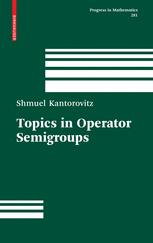

Most ebook files are in PDF format, so you can easily read them using various software such as Foxit Reader or directly on the Google Chrome browser.
Some ebook files are released by publishers in other formats such as .awz, .mobi, .epub, .fb2, etc. You may need to install specific software to read these formats on mobile/PC, such as Calibre.
Please read the tutorial at this link: https://ebookbell.com/faq
We offer FREE conversion to the popular formats you request; however, this may take some time. Therefore, right after payment, please email us, and we will try to provide the service as quickly as possible.
For some exceptional file formats or broken links (if any), please refrain from opening any disputes. Instead, email us first, and we will try to assist within a maximum of 6 hours.
EbookBell Team

4.3
98 reviewsThe theory of operator semigroups was essentially discovered in the early 1930s. Since then, the theory has developed into a rich and exciting area of functional analysis and has been applied to various mathematical topics such as Markov processes, the abstract Cauchy problem, evolution equations, and mathematical physics.
This self-contained monograph focuses primarily on the theoretical connection between the theory of operator semigroups and spectral theory. Divided into three parts with a total of twelve distinct chapters, this book gives an in-depth account of the subject with numerous examples, detailed proofs, and a brief look at a few applications.
Topics include:
* The Hille–Yosida and Lumer–Phillips characterizations of semigroup generators
* The Trotter–Kato approximation theorem
* Kato’s unified treatment of the exponential formula and the Trotter product formula
* The Hille–Phillips perturbation theorem, and Stone’s representation of unitary semigroups
* Generalizations of spectral theory’s connection to operator semigroups
* A natural generalization of Stone’s spectral integral representation to a Banach space setting
With a collection of miscellaneous exercises at the end of the book and an introductory chapter examining the basic theory involved, this monograph is suitable for second-year graduate students interested in operator semigroups.